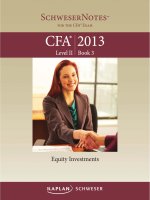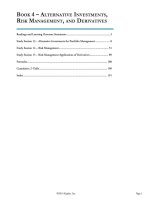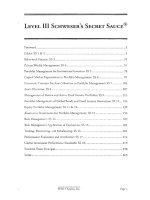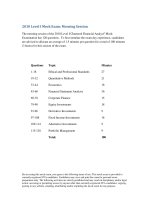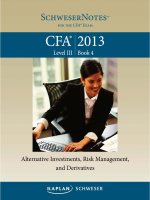CFA level 3 mock exam 6 level 3 mock 2017
Bạn đang xem bản rút gọn của tài liệu. Xem và tải ngay bản đầy đủ của tài liệu tại đây (606.23 KB, 192 trang )
FinQuiz.com
CFA Level III Mock Exam 6
June, 2017
Revision 1
Copyright © 2010-2017. FinQuiz.com. All rights reserved. Copying, reproduction
or redistribution of this material is strictly prohibited.
CFA Level III Mock Exam 6 – Solutions (AM)
FinQuiz.com – 6th Mock Exam 2017 (AM Session)
The morning session of the 2017 Level III CFA Examination has 11 questions. For
grading purposes, the maximum point value for each question is equal to the number of
minutes allocated to that question.
Questions
1
2
3
4
5
6
7
8
9
10
11
Topic
Minutes
Portfolio Management – Individual
Portfolio Management – Individual
Portfolio Management – Individual
Portfolio Management – Individual
Portfolio Management – Institutional
Portfolio Management – Economics
Portfolio Management – Equity Investments
Portfolio Management – Fixed Income
Portfolio Management – Risk Management
Portfolio Management – Derivatives
Portfolio Management – Monitoring and Rebalancing
31
12
18
9
22
24
12
16
14
10
12
Total:
FinQuiz.com © 2017 - All rights reserved.
180
2
CFA Level III Mock Exam 6 – Solutions (AM)
QUESTION 1 HAS FIVE PARTS (A, B, C, D, E) FOR A TOTAL OF 31 MINUTES
Cynthia McCollum, CFA, is a portfolio manager at Western Brookes, an asset advisory
firm. Hart has been asked to construct an investment portfolio for Mona Hart, a senior
manager at a manufacturing enterprise. McCollum collects the following information on
Hart:
•
•
•
•
•
•
Hart is 52 years old and is the divorced mother of two sons, aged 8 and 12
respectively.
Her living expenses are protected against inflation and amount to $350,000 per
annum.
Her annual salary offsets her living expenses on an inflation-adjusted basis
without leaving any funds for saving purposes. Her salary is expected to grow at
the annual inflation rate of 4%. The inflation rate is expected to remain the same
for the indefinite future.
She expects her living expenses to reduce by 20% upon her retirement, which is
ten years from today.
She is taxed at a rate of 35% on all income, dividends and capital gains.
She has recently received $3 million from her deceased father’s estate which she
wishes to employ for investment purposes.
During McCollum’s meeting with Hart, the client makes two statements which the
manager feels are essential to incorporate in the decision making process.
Statement 1: “My past experience with a venture capital fund investment was unpleasant.
Long lock-up periods and high losses meant that my funds were tied up in a
poorly performing asset class for quite some time. I would request
refraining from all types of alternative asset classes.”
Statement 2: “I would not like my investment portfolio to decline by more than 15% in
nominal terms in any given year and will be satisfied with an annual pretax real return of 2.5%.”
A. Formulate the return objective of an investment policy statement for Hart.
Calculate the after-tax nominal return requirement to achieve this objective
assuming that the inheritance is invested in accordance with the stated before-tax
real rate of return. Show your calculations.
(6 minutes)
FinQuiz.com © 2017 - All rights reserved.
3
CFA Level III Mock Exam 6 – Solutions (AM)
B. Formulate the risk objective for Hart’s investment portfolio.
(5 minutes)
C. Construct the constraints section of the investment policy statement. Your
answer should address:
i.
ii.
iii.
taxes
liquidity
time horizon.
(6 minutes)
D.
i.
Determine the behavioral trait exhibited by Hart according to the principles
of behavioral finance. Justify your response.
(3 minutes)
ii.
Considering both her statements, determine three consequences of Hart’s
personality type.
(3 minutes)
McCollum proposes four alternative strategic allocations for Hart’s investment portfolio
in the exhibit on next page:
FinQuiz.com © 2017 - All rights reserved.
4
CFA Level III Mock Exam 6 – Solutions (AM)
Cash and equivalents
Corporate bonds
Large-cap US stocks
Small-cap US stocks
International stocks
Venture capital
Total
Exhibit:
Proposed Strategic Allocations for
Hart’s Investment Portfolio
Allocation
A
B
C
(%)
(%)
(%)
15
5
12
55
20
15
12
25
25
10
30
28
8
20
20
0
10
0
100
100
100
Expected nominal after-tax return (%)
Expected standard deviation (%)
Sharpe ratio
7.4
9.4
0.574
11.5
14.8
0.642
8.4
10.5
0.609
D
(%)
20
5
50
15
35
3
100
10.9
12.8
0.695
E. Determine which allocation is most suitable for satisfying Hart’s investment
objectives. Justify your response with four reasons.
(8 minutes)
FinQuiz.com © 2017 - All rights reserved.
5
CFA Level III Mock Exam 6 – Solutions (AM)
QUESTION 2 HAS THREE PARTS (A, B, C) FOR A TOTAL OF 12 MINUTES
The Trust Department of Granton Advisory oversees the portfolios of high net-worth
private clients. Sean McEwen is the department’s senior trust officer who is responsible
for overseeing the accounts of five clients.
In the current year McEwen will be changing his investment approach and base his
investment decisions on the psychographic characteristics of investors. He will be
applying the following models to make classify investors:
i.
ii.
Barnewall Two-Way Model
Bailard, Biehl, and Kaiser (BB&K) Five-Way Model
A. Discuss one use and one limitation of classifying investors into personality types.
(2 minutes)
Model ‘i’ will be used to classify Sigmund Castro, one of McEwen’s clients. Castro is a
chief executive officer of a steel manufacturing concern owning a minority stake in the
firm. Castro has been responsible for the company’s stock price doubling in just less than
five years. His experimentation with corporate strategy has been the sole reason for the
company’s success and growth in his financial wealth.
B. Applying Model ‘I’ to classify Castro, determine:
i.
ii.
the appropriate classification category and
his risk tolerance relative to need for security.
(2 minutes)
Four of McEwen’s clients have varying degrees of investment experience. He will be
using Model ‘ii’ to classify these clients based on excerpts obtained from client
interviews.
Jill Marc: “The reason for becoming a stock broker is that I am confident in my intuition.
However, it is imperative that all my investment decisions be supported by well-reasoned
economic analysis.”
Stephen Dale: “I have spent many years building a solid asset base. Having started with
almost nothing, I cannot bear losing it to irrational decision-making.”
FinQuiz.com © 2017 - All rights reserved.
6
CFA Level III Mock Exam 6 – Solutions (AM)
Arnold Peterson: “I have to admit that there is a certain thrill to taking on risks especially
when the outcome is uncertain.”
Kevin Singh: “I am the most enthusiastic amongst my fellow colleagues when it comes to
making investment decisions. While I do like to form opinions, I prefer
screening my ideas by asking for assistance from an experienced individual
and opting for those which are most suitable from a risk and return
perspective.”
C. Classify each of the four clients according to Model ‘ii’. Justify your
classification.
Answer Question 2-C in the template provided 0n page 8.
(8 minutes)
FinQuiz.com © 2017 - All rights reserved.
7
CFA Level III Mock Exam 6 – Solutions (AM)
Template for Question 2-C
Classify Each
of the Four
Clients
According to
Model ‘ii’
Excerpt
Justify Your Classification
Marc: “The reason for
becoming a stock broker is
that I am confident in my
intuition. However, it is
imperative that all my
investment decisions be
supported by well-reasoned
economic analysis.”
Dale: “I have spent many
years building a solid asset
base. Having started with
almost nothing, I cannot bear
losing it to irrational decisionmaking.”
Peterson: “I have to admit that
there is a certain thrill to
taking on risks especially
when the outcome is
uncertain.”
FinQuiz.com © 2017 - All rights reserved.
8
CFA Level III Mock Exam 6 – Solutions (AM)
Singh: “I am the most
enthusiastic amongst my
fellow colleagues when it
comes to making investment
decisions. While I do like to
form opinions, I prefer
screening my ideas by asking
for assistance from an
experienced individual and
opting for those which are
most suitable from a risk and
return perspective.”
FinQuiz.com © 2017 - All rights reserved.
9
CFA Level III Mock Exam 6 – Solutions (AM)
QUESTION 3 HAS TWO PARTS (A, B) FOR A TOTAL OF 18 MINUTES
The Walkers reside in Gratina, a country with an emerging market and currency pegged
to the US dollar. The couple is seeking a professional to advise them on how to transfer
their $50 million investment portfolio to their daughter, Cynthia, in a tax-efficient
manner. They have come to Abdul Rasool, CFA, who is a tax advisor, for a solution.
After analyzing the couple’s portfolio, Rasool determines that stocks and bonds
comprising the portfolio earn a pre-tax return of 8% and 6% respectively. The asset
classes are held in the proportion 80 stocks/20 bonds. He also determines that the couple
has an expected life expectancy of 20 years.
Rasool devises two alternative wealth transfer strategies both of which account for the
fact that bequests are taxed at a rate of 50%. Cynthia pays a marginal tax rate of 30%.
Current tax laws permit tax-free transfer of up to $25 million.
The first strategy will involve gifting the portfolio to Cynthia.
A. Determine the after-tax value of the portfolio if the first strategy is executed.
Your answer should discuss whether this strategy should be recommended based
on the change in the value of the investment over the investment horizon. Show
your calculations.
(6 minutes)
The second strategy involves placing bonds in Cynthia’s investment account while
retaining equities in the couple’s investment account. Rasool proceeds with this strategy
by making the necessary allocations. Immediately after doing so, Rasool realizes that
placing equities in Cynthia’s account will be more advantageous from a tax perspective.
He now sets out to determine the adjustments will be required to the investment accounts
to ensure the post-tax weights are kept constant.
B. Determine the magnitude of adjustments which Rasool will need to make to the
investment accounts to ensure that the original allocation is maintained. Show
your calculations.
(12 minutes)
FinQuiz.com © 2017 - All rights reserved.
10
CFA Level III Mock Exam 6 – Solutions (AM)
QUESTION 4 HAS ONE PART FOR A TOTAL OF 9 MINUTES
Benjamin Streak recently retired from Cable Inc concluding his thirty year tenure as chief
financial officer. Over the course of Streak’s employment, he accumulated 200,000
shares of company stock as bonus for his exemplary performance. The shares are
currently trading at a price of $30 per share.
Streak’s investment portfolio is being managed by Natasha Craig, his asset advisor. Craig
determines that diversification of the large stock position is crucial to avoid concentration
risk. She discusses the matter with Streak and jots down the following points regarding
her client’s requirements:
•
•
•
•
•
The chosen diversification strategy should be optimal from a tax perspective.
Streak would like to retain voting rights and any dividend income
He would like to minimize any transaction costs
He would like to avoid the use of financial leverage
He would like to retain upside potential
Determine whether each of the following strategies is appropriate or inappropriate to
diversify Streak’s concentrated stock position:
i.
ii.
iii.
Outright sale
Equity monetization
Hedging
Justify each answer by providing two reasons.
Answer Question 4 in the template provided on page 12.
(9 minutes)
FinQuiz.com © 2017 - All rights reserved.
11
CFA Level III Mock Exam 6 – Solutions (AM)
Template for Question 4
Strategy
Determine Whether Each
Strategy is Appropriate or
Inappropriate
(Circle the Correct
Answer)
Justify Each Answer by
Providing Two Reasons
Appropriate
i.
Outright sale
Inappropriate
Appropriate
ii.
Equity monetization
Inappropriate
Appropriate
iii.
Hedging
Inappropriate
FinQuiz.com © 2017 - All rights reserved.
12
CFA Level III Mock Exam 6 – Solutions (AM)
QUESTION 5 HAS FOUR PARTS (A, B, C, D) FOR A TOTAL OF 22 MINUTES
The Carter Foundation has endowed The Music Fund (MF), a recently established
organization with provide funding to aspiring musicians seeking formal education. The
fund receives grants from donors located across the globe and is headquartered in Sri
Lanka. MF has received $30 million in grants to date. MF’s policy portfolio is being
managed by Wes Moore, an asset manager.
The foundation’s chief investment officer (CIO) has mandated that the fund set aside
20% of its annual grant-making and spending budget in a reserve. MF’s CIO has
estimated this amount at an average of $10 million per annum for decision making
purposes. MF’s management is not permitted to spend this amount until the 12-month
average asset value is known with certainty.
The CIO makes note that the foundation has overspent its budget in the current year. In
response to the overspending situation, the CIO states, “We are fortunate to be allowed to
carry-back and carry-forward our annual spending. Therefore, overspending in excess of
the 5% annual spending rule should be beneficial to MF in the long-run.”
In the current year, MF receives a $5 million grant from Michael Thomas, the CEO of a
music records company. The grant has been awarded in the form of ownership rights to
the record company’s stock. The CEO has expressly instructed the CIO to avoid
diversifying the fund as it will reduce exposure to the stock.
The CIO estimates that annual portfolio management expenses will amount to 1.2%.
Annual inflation is at 3% and is expected to remain at this rate for the indefinite future.
A. Formulate the return and risk objectives of MF’s IPS. Show your calculations
where necessary.
(6 minutes)
B. Formulate the constraints section of MF’s IPS. Your answer should address the
following and assume the CIO’s estimate with respect to annual grant-making and
spending is accurate:
i.
ii.
iii.
time horizon
liquidity requirements
unique circumstances
FinQuiz.com © 2017 - All rights reserved.
13
CFA Level III Mock Exam 6 – Solutions (AM)
Answer Question 5-B in the template provided on page 15.
(6 minutes)
C. Evaluate the impact of a cash reserve fund on grants paid out by MF in a
particular ‘up’ year.
(2 minutes)
Moore proposes four alternative asset allocations for the MF policy portfolio. Data
concerning expected risk, return and asset class weights has been summarized in the
exhibit below.
Exhibit:
Proposed Asset Allocations for the MF Policy Portfolio
Cash and cash equivalents
Domestic equities
Music record company stock
Global equities
Long-term government bonds
BB-rated domestic Corporates
Global bonds
Venture capital
Total
A
(%)
6
30
14
15
9
14
11
1
100
Allocations
B
C
(%)
(%)
3
0
25
25
14
10
23
10
0
8
15
12
20
20
0
15
100
100
D
(%)
10
5
14
0
8
40
23
0
100
Expected after-tax return
Expected standard deviation
Sharpe ratio
9.6
11.0
0.69
14.8
17.0
0.75
9.2
10.7
0.67
21.3
29.4
0.66
D. Select the asset allocation most appropriate for MF’s portfolio. Support your
answer by providing four reasons. Assume that the CIO’s estimate with respect to
annual grant-making and spending budget is accurate.
(8 minutes)
FinQuiz.com © 2017 - All rights reserved.
14
CFA Level III Mock Exam 6 – Solutions (AM)
Template for Question 5-B
Constraints
Formulate the Constraints Section of
The MF’s IPS
Time horizon
Liquidity requirements
Unique circumstances
FinQuiz.com © 2017 - All rights reserved.
15
CFA Level III Mock Exam 6 – Solutions (AM)
QUESTION 6 HAS FOUR PARTS (A, B, C, D) FOR A TOTAL OF 24 MINUTES
Hanna Abdul, CFA, is an independent economic analyst. For her recent study, Abdul will
be comparing the values of the Canadian dollar (CAD) relative to the U.S. dollar (USD)
observed over the years 2012 to 2014. Upon concluding the assignment, she intends to
value a developed market equity index based on economic fundamentals.
During 2012 and 2013, the CAD appreciated strongly against the USD with its value
rising from $0.75 in 2014 to $0.90 in 2013. However, beginning 2014, the USD rose in
value and began to accelerate resulting in the CAD falling to $0.55. Based on purchasing
power parity, the long-run value of the CAD is expected to fall in the range of $0.50 to
$0.85.
Based on her finding Abdul attempts to explore the reasons underlying the swings in the
value of the CAD. She employs the relative economic strength, capital flows, and savings
investment imbalances approach deriving the following conclusions:
Conclusion 1: “According to the relative economic strength approach, the rise in the
value of the CAD can be attributed to positive domestic economic growth
resulting from falling unemployment levels and increased business
activity. Despite the decline in the value of the CAD in 2014, economic
growth was still found to be higher relative to that observed in the US. “
Conclusion 2: “According to the capital flows approach, the U.S. observed a capital
account surplus in 2012 and 2013.”
Conclusion 3: “According to the savings-investment imbalances, the Canadian economy
was under pressure to increase investment and reduce domestic savings
opening up the current account deficit in 2012 and 2013. In 2014,
companies were required to cut back on borrowing and spending. The
CAD fell back in value as companies were required to balance the current
account.”
A. Determine whether each conclusion is correct or incorrect. Justify your response.
Answer Question 6-A in the Template provided on page 18.
(12 minutes)
FinQuiz.com © 2017 - All rights reserved.
16
CFA Level III Mock Exam 6 – Solutions (AM)
Abdul is cognizant of the fact that the government is limited in its ability to control
exchange rates with market intervention. She aims to discuss this matter in a report
summarizing her observations of the USD/CAD exchange rate.
B. Identify three factors which limit the ability of governments to control exchange
rates with market intervention.
(3 minutes)
Next, Abdul analyzes a developed market equity index comprising 5,000 stocks. The
issuers are large and mature companies operating in a mature economy. The value of the
index on the date of analysis, January 20, 2014, was $35,000. The forecasted 12-month
dividends per share of the index constituents are $150. Due to the mature nature of index
constituents, Abdul projects that inflation-adjusted earnings and dividends will equal to
that of GDP. The relevant economic data to value the index has been summarized in the
exhibit below.
Exhibit:
Economic Data Relevant to Valuing the Index
Long-term inflation-adjusted growth in capital stock
4.1%
Long-term labor force growth
- 0.4%
Total factor productivity (TFP) growth
1.2%
Output elasticity of capital
0.6
C. Estimate the inflation-adjusted discount rate to perpetuity using the CobbDouglas production function and Gordon growth model. Show your calculations.
(4 minutes)
As of the end of 2014, Abdul discovers that the index is trading 25% below the level
observed twelve months earlier. He notes that stock issuers have coincidently maintained
a constant dividend yield in the current and previous two years.
D. Determine which of the following factors – actual dividends paid, required return
on equity, or long-term, real dividend growth – contributes to the price decline.
Justify your response.
Answer Question 6-D in the template provided on page 19.
(5 minutes)
FinQuiz.com © 2017 - All rights reserved.
17
CFA Level III Mock Exam 6 – Solutions (AM)
Template for Question 6-A.
Determine whether
each conclusion is
correct or incorrect.
(Circle the Correct
Choice)
Conclusion 1: “According to the
relative economic strength approach,
the rise in the value of the CAD can
be attributed to positive domestic
economic growth resulting from
falling unemployment levels and
increased business activity. Despite
the decline in the value of the CAD
in 2014, economic growth was still
found to be higher relative to that
observed in the US.”
Conclusion 2: “According to the
capital flows approach, the U.S.
observed a capital account surplus in
2012 and 2013.”
Conclusion 3: “According to the
savings-investment imbalances, the
Canadian economy was under
pressure to increase investment and
reduce domestic savings opening up
the current account deficit in 2012
and 2013. In 2014, companies were
required to cut back on borrowing
and spending. The CAD fell back in
value as companies were required to
balance the current account.”
Justify Your Response.
Correct
Incorrect
Correct
Incorrect
Correct
Incorrect
FinQuiz.com © 2017 - All rights reserved.
18
CFA Level III Mock Exam 6 – Solutions (AM)
Template for Question 6-D
Determine which of the
following factors supports a
price decline
(Circle the Answer (s))
Justify Your Response
Long-term, real dividend
growth
Required return on equity
Dividends paid
FinQuiz.com © 2017 - All rights reserved.
19
CFA Level III Mock Exam 6 – Solutions (AM)
QUESTION 7 HAS FOUR PARTS (A, B, C, D) FOR A TOTAL OF 12 MINUTES
Hailey Bronso is surgeon running his own medical practice. He is seeking to hire an
equity manager for his $1 million portfolio. He prepares an equity manager questionnaire
and sends it out to various investment management firms. Based on the results collected,
Bronso attempts to narrow his selection to firms employing the top-down forecasting
approach, with a historical record of achieving excess returns relative to their
benchmarks, and delegating responsibility within the organization for asset allocation and
research in an appropriate manner.
A. Identify the sections of the equity management questionnaire Bronso should pay
attention to when:
I.
II.
III.
selecting investment management firms which use the top-down
forecasting approach
determining the investment management firm’s capability of generating an
excess returns relative to the benchmark
determining how responsibility is delegated within the organization.
(3 minutes)
After considerable research, Bronso engages North Advisory. Bronso’s investment will
be made in a fund with a quoted base fee rate of 0.50% of beginning AUM plus 30% of
performance in excess of the Russell 3000 index.
B. Discuss two relative strengths and two relative weaknesses of adopting a
performance-fee based structure.
Answer Question 7-B in the template provided on page 22.
(4 minutes)
FinQuiz.com © 2017 - All rights reserved.
20
CFA Level III Mock Exam 6 – Solutions (AM)
While Bronso enjoys a certain level of risk taking, he has expressed his desire of placing
a limit on the investment manager’s ability to take risk.
C. Identify a feature which can alleviate Bronso’s concern with respect to risktaking.
(1 minute)
Four years later, Bronso evaluates the performance of North Advisory’s equity fund
relative to the benchmark index, Russell 3,000 equity index. The fund is subject to a high
water mark.
Exhibit:
Performance of the North Advisory
Equity Fund Relative to the Benchmark Index
Russell 3,000
Ending Net
Beginning Net
Index Value
Asset Value*
Year
Asset Value (in
(in Millions)
(in Millions)
Millions)
1
$10.0
$13.0
$12.0
2
$13.0
$9.5
$11.5
3
$9.5
$11.0
$11.7
4
$11.0
$11.9
$11.2
*Gross of investment management fees
D-i. Determine the value of the high water-mark, gross of investment management
fees, at the end of the third year.
D-ii. Determine the amount of fees which will be received by North Advisory in the
fourth year, Show your calculations.
(4 minutes)
FinQuiz.com © 2017 - All rights reserved.
21
CFA Level III Mock Exam 6 – Solutions (AM)
Template for Question 7-B
Discuss two relative strengths and two relative weaknesses of adopting a
performance-fee based structure.
Strengths:
1.
2.
Weaknesses:
1.
2.
FinQuiz.com © 2017 - All rights reserved.
22
CFA Level III Mock Exam 6 – Solutions (AM)
QUESTION 8 HAS THREE PARTS (A, B, C) FOR A TOTAL OF 16 MINUTES
AR Manufacturing offers a defined benefit pension plan. The average age of participants
covered by the plan is 35 years. To finance the fund’s liabilities, the chief investment
officer (CIO) has constructed a portfolio of three bond issues. The duration of the
portfolio has been set such that it matches that of the average liability structure.
Exhibit 1 presents the initial duration of the bond portfolio from the time it was first
constructed.
Exhibit 1:
Initial Duration and Dollar Duration of Bond Portfolio
Market price ($
per 100 of par
Yield (%)
Duration
value)
Issuer
Holmes Inc
99.85
4.113
5.6
Theta plc
97.30
4.506
6.2
Lakehouse Corp
105.67
8.327
9.0
Dollar duration
$1,083,213.705
One year after constructing the portfolio, the yield curve shifts upwards thereby
decreasing the market prices of the bonds. Exhibit 2 presents the new prices of the three
issues. The CIO is seeking to rebalance the portfolio such that the original dollar duration
is maintained.
Exhibit 2:
Revised Duration and Dollar Duration of Bond Portfolio
Market price ($
per 100 of par
Issuer
value)
Duration
Yield (%)
Holmes Inc
98.30
3.420
6.6
Theta plc
96.42
3.988
7.2
Lakehouse Corp
100.05
7.589
10.0
Dollar duration
$929,768.515
FinQuiz.com © 2017 - All rights reserved.
23
CFA Level III Mock Exam 6 – Solutions (AM)
A. Determine the cash required to rebalance the portfolio.
(2 minutes)
Rather than investing in each of the three bond issues, the CIO devises an alternative
strategy for rebalancing the portfolio, which involves selling the Lakehouse Corp issue
and investing the proceeds equally in the remaining issues. The par value of the
Lakehouse Corp bond is $7.56 million.
B. Determine the total par value required to maintain the hedge. Show your
calculations.
(8 minutes)
The CIO recommends constructing a multiple asset portfolio to immunize the pension
plan’s liability stream. He attempts to determine the conditions which will be required to
assure this immunization strategy (presented below):
1. The duration of the portfolio should equal to the average age of the participants,
35.
2. The portfolio should contain an asset with a duration equal to or less than the
duration of the shortest duration liability.
3. The portfolio must be constructed to incorporate parallel and non-parallel yield
curve shifts.
C. Determine which of the stated conditions is correct. Justify your response.
Answer Question 8-C in the template provided on page 25.
(6 minutes)
FinQuiz.com © 2017 - All rights reserved.
24
CFA Level III Mock Exam 6 – Solutions (AM)
Template for Question 8-C
Determine whether the
stated condition is correct.
(Circle the Correct
Answer)
Condition
The duration of the portfolio
should equal to the average
age of the participants, 35.
Justify Your Response
Correct
Incorrect
The portfolio should contain
an asset with a duration
equal to or less than the
duration of the shortest
duration liability.
The portfolio must be
constructed to incorporate
parallel and non-parallel
yield curve shifts.
Correct
Incorrect
Correct
Incorrect
FinQuiz.com © 2017 - All rights reserved.
25
